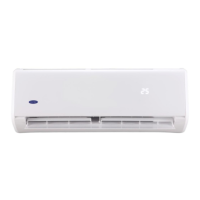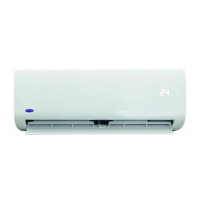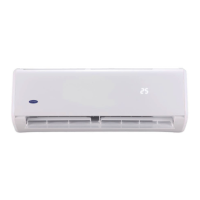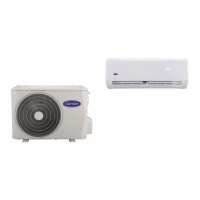Carefully bend the tubing in the middle
according to the diagram below. DO NOT
bend the tubing more than 90° or more t
han 3 times.
NOTE: DO NOT intertwine signal cable
with other wires. While bundling these
items together, do not intertwine or cross
the signal cable with any other wiring.
6. REFRIGERANT PIPING CONNECTION
7GB-14
4. Remove PVC tape from ends of pipe
when ready to perform flaring work.
5. Clamp flare form on the end of the pipe.
The end of the pipe must extend beyond
the flare form.
Flare form
Pipe
Fig. 6.4
6.
Place flaring tool onto the form.
7. Turn the handle of the flaring tool
clockwise until the pipe is fully flared.
Flare the pipe in accordance with the
dimensions shown in table 6.1.
Table 6.1: PIPING EXTENSION BEYOND FLARE
FORM
Pipe
gauge
Tightening
torque
Flare dimension (A)
(Unit: mm)
Flare shape
Min. Max.
Ø 6.4
14.2-17.2 N.m
(144-176 kgf.cm)
8.3 8.3
R0.4~0.8
45
°
±
2
90
°
±
4
A
Fig. 6.5
Ø 9.5
32.7-39.9 N.m
(333-407 kgf.cm)
12.4 12.4
Ø 12.7
49.5-60.3 N.m
(504-616 kgf.cm)
15.4 15.8
Ø 15.9
61.8-75.4 N.m
(630-770 kgf.cm)
18.6 19
Ø 19.1
97.2-118.6 N.m
(990-1210 kgf.cm)
22.9 23.3
8. Remove the flaring tool and flare form,
then inspect the end of the pipe for
cracks and even flaring.
Step 4: Connect pipes
Connect the copper pipes to the indoor unit
first, then connect it to the outdoor unit. You
should first connect the low-pressure pipe,
then the high-pressure pipe.
1. When connecting the flare nuts, apply
a thin coat of refrigeration oil to the
flared ends of the pipes.
2. Align the center of the two pipes that
you will connect.
Indoor unit tubing
Flare nut
Pipe
Fig. 6.6
3. Tighten the flare nut as tightly as
possible by hand.
4. Using a spanner, grip the nut on the unit
tubing.
5. While firmly gripping the nut, use a
torque wrench to tighten the flare nut
according to the torque values in table
7.1.
NOTE: Use both a spanner and a torque
wrench when connecting or disconnecting
pipes to/fromthe unit.
Fig. 6.7
CAUTION
• Ensure to wrap insulation around the
piping. Direct contact with the bare piping
may result in burns or frostbite.
• Make sure the pipe is properly connected.
Over tightening may damage the bell
mouth and under tightening may lead to
leakage.
NOTE ON MINIMUM BEND RADIUS
Bend the pipe with thumb
min-radius 10cm (3.9”)
Fig. 6.8
6. After connecting the copper pipes to
the indoor unit, wrap the power cable,
signal cable and the piping together
with binding tape.
7. Thread this pipeline through the wall
and connect it to the outdoor unit.
8. Insulate all the piping, including the
valves of the outdoor unit.
9. Open the stop valves of the outdoor
unit to start the flow of the refrigerant
between the indoor and outdoor unit.
CAUTION
Check to make sure there is no refrigerant
leak after completing the installation work.
If there is a refrigerant leak, ventilate the
area immediately and evacuate the system
(refer to the Air Evacuation section of this
manual).
Ø 22
109.5-133.7 N.m
(1117-1364 kgf.cm)
27 27.3
GB
